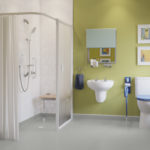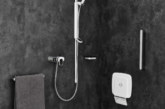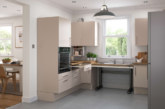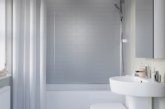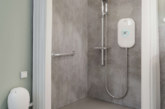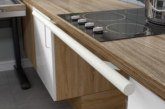Stuart Reynolds, Head of Product and Marketing at AKW, a leading provider of accessible home solutions, discusses the launch of a new guide that will help housing associations create more dementia-friendly bathrooms.
A report by the All Party Parliamentary Group on Housing and Care for Older People, released early in 2021, states that ‘there is an urgent need to ensure that housing is ‘dementia-ready’ from the outset.’ It also highlighted that ‘the social sector needs to grow and provide more dementia-ready and adapted housing’. With one in 14 aged over 65 and one in six aged 80+ living with dementia, the need is already significant.
Why are bathrooms so challenging for those with dementia?
Dementia can cause someone’s perception of danger to steadily diminish, and the bathroom can become a dangerous and confusing place. People with dementia are twice as likely to fall and these falls result in significantly higher mortality rates than for others in the same age group. In the standard bathroom layout hazards are numerous and include trip points, slippery floors, hot water and confusing layouts. For those with dementia the bathroom can become a challenging and sometimes frightening place that can cause upset, frustration and a reluctance to use it.
According to the Alzheimer’s Society, the number of people with dementia is steadily increasing and careful planning is required to manage their care and support. AKW’s new guide to creating dementia-friendly bathrooms has been produced with advice and support from specialist dementia design advisers at the University of Stirling’s Dementia Services Development Centre (DSDC). The aim of the guide is to offer housing associations, installers and the general public best practice guidance on designing this important space.
Things need to change, as at present only 11.5% of local authorities mention dementia in their housing assistance policies. The All Party Parliamentary Group on Housing and Care for Older People report gives social landlords recommendations for getting prepared for dementia. As well as encouraging social networks in communities, preventative changes are suggested to help people live more independently for longer. Part of the considerations includes looking at the hard design of bathrooms that enable independence.

What is a dementia-friendly bathroom?
Importantly, a dementia-friendly bathroom doesn’t need to cost more than a standard bathroom adaptation, but the products and guidelines regarding colour etc. need to be followed to ensure maximum safety and comfort. A dementia-friendly bathroom needs to protect the user from scalding, falls and visual confusion. To do this a range of design techniques need to be employed:
Protection against scalding — Someone with dementia may progressively lose safety awareness and as a result they will become more vulnerable to scalding. Opt for thermostatic taps and showers and use low surface temperature radiators and under-floor heating if possible.
Protection against falls — Avoid sharp edges, install a level access shower instead of a bath, include a shower seat, PET shower screens instead of glass, and shower curtains made from a breathable fabric to prevent suffocation if a person falls. Also ensure that the floor is a single colour to avoid a colour change being mistaken for a step, steer clear of shiny flooring (as this can be perceived as wet), flecked flooring (it can be seen as dirty) and dark flooring (potentially mistaken for a big hole, making the person with dementia reluctant to step on it).
Protection against confusion — Short-term memory loss and forgetfulness and visual confusion are both symptoms of dementia. To help overcome these issues in the bathroom, opt for a shower with an automatic switch off, flood-proof plugs (or no plugs at all) and choose retro-style taps and flush handles. Also ensure any mirrors have a roller blind or can be covered if needed. Finally, use contrasting colours to define the shower and toilet areas so the user can locate them easily (surfaces that have a light reflectance value of 30 points of difference achieve good contrast).
Choosing the right products can significantly help those living with dementia, that is why AKW has developed a range of products that are ideal for use in a dementia-friendly bathroom. From thermostatic care showers and contrasting toilet seats and grab rails, to non-slip flooring in a range of colours that will clearly contrast with the walls and task-specific lighting, AKW has it all.

